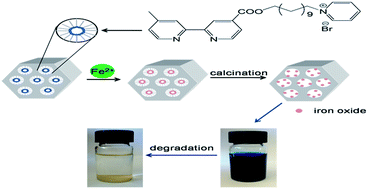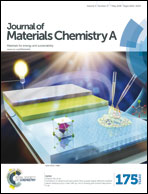Preparing a highly dispersed catalyst supported on mesoporous microspheres via the self-assembly of amphiphilic ligands for the recovery of ultrahigh concentration wastewater†
Abstract
A highly dispersed catalyst supported on mesoporous microspheres was prepared via the self-assembly of amphiphilic ligands. In a mixed solvent of water and ethanol, mesoporous microspheres were fabricated using bipyridine-based amphiphilic molecules as structure-directing agents for self-assembly with tetraethoxysilane. The microspheres had an average diameter of 979 nm, and their surface area and pore size were 720 m2 g−1 and 2.86 nm, respectively. Solid-state nuclear magnetic resonance characterization revealed the synthesized mesoporous microspheres display a special coordination effect with ferrous ions. Transmission electron microscopy analysis and energy-dispersive X-ray spectroscopy element mapping indicated that iron oxide was highly decentralized in the mesoporous microspheres after calcination in an O2 atmosphere. Loading iron oxide onto the mesoporous material via the impregnation method produced a completely different effect, with the iron oxide particles larger outside the mesoporous channels. The activity of the obtained catalyst was investigated using a Fenton reaction. In this reaction, the synthesized highly dispersed catalyst displayed strong catalytic activity in dye degradation, even when the dye concentration was as high as 400 ppm. The dye was almost entirely removed within 6 h, and the catalyst could be reused many times.


 Please wait while we load your content...
Please wait while we load your content...